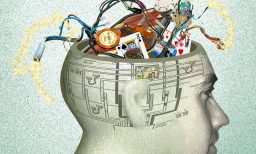Often we do not realize that we are driven by stereotyped thinking, strangers, imposed from the outside, attitudes, elemental emotions, anxiety, and even phobias. When making decisions, do you constantly get the wrong results you were counting on? Think in a pattern or independently, do you control your life yourself or act under the direction of something unconscious? Cognitive-behavioral therapy will help answer these difficult questions.
Material Content:
History of Cognitive Behavioral Psychotherapy
The method arose in the second half of the last century on the basis of D. Watson's earlier works on behaviorism, or behavioral psychology. In the sixties of the 20th century, a psychologist from the United States A. Ellis substantiated the relationship of erroneous cognitions (attitudes) and human behavior. Ellis's compatriot - psychotherapist A. Beck - came to similar conclusions in the course of his own research, regardless of his colleague. He went further than behaviorists who put human behavior at the forefront and created a theory according to which our thoughts, attitudes, ideas directly affect actions, choices.
The method, revolutionary for the therapists of that time, arose in opposition to the then prevailing psychoanalysis, but quickly won its fans and took root in the practice of work.
Basic principles of CBT
10 fundamental principles have been developed on which the therapist's work is based:
- Constant updating of the problem studied under the CBT. The patient during the sessions changes, develops. His situation is a dynamic indicator, not a static one.With each new step in self-awareness, his situation changes and requires fixing by a specialist leading the process. During the sessions, the therapist must constantly update his understanding of the patient.
- The ligament “researched - therapist” must be strong and strong, nothing should interfere with the therapeutic connection. Only in conditions of complete trust and emotional acceptance of the opposite side can a person not only open up, but plunge into himself, understand deep thoughts and feelings, share them with another person.
- Interconnected active work of two. The treatment process in this case is exclusively a team work. The emphasis during the sessions may shift slightly from one side to the other, but in any case it should be equal partnership, cooperation.
- A goal should never be lost sight of. Formulating, evaluating and gradually solving the main problem is the road to achieving the originally set goal. Each step taken jointly by the patient and the therapist during cognitive-behavioral psychotherapy should certainly lead to the planned result.
- The problem exists here and now, and only in the present should it be eliminated. The past and future are viewed only through the prism of the present. Any appeal to something other than the present state should be justified by the purpose and necessity of deviation from the course.
- The main task of the doctor is not only to reveal the essence of the problem and work it out with the patient, but also to teach this process. The subject must become his own object of study, learn to see the negative moments in himself, to fix and predict or eliminate them.
- The therapy process is not endless. It should fit into a certain number of sessions, the maximum number usually does not exceed 14. The frequency can be different, it is determined by the therapist and depends on the situation.
- The therapist during each individual meeting acts strictly according to plan, creating a clear structure of the session. This allows you to spend time and effort as efficiently as possible, and achieve your goal faster. Also, sessions quickly become understandable and familiar to the patient. Subsequently, he will be able to use the already familiar rhythm and sequence of stages in independent work on himself.
- CBT, using various techniques, teaches a person to find dysfunctional thoughts, decisions, conclusions, attitudes and otherwise respond to them in their thinking flow.
- The methods are used to change the habitual (destructive) attitudes, behavior and mood of a person, which prevent him from functioning qualitatively, into productive ones.
Effective methods and techniques of therapy
With the development of behaviorism, a number of methods have been determined and tested, which work most productively on the awareness and correction of the thoughts and behavior of the subject.
For each type of personality disorder, their techniques are shown, but all of them can be grouped by direction of exposure:
- Control the flow of thought. The goal of these techniques is to fix thoughts, evaluate them in terms of functionality or usefulness for a particular individual, and understand that they arise automatically. Techniques: keeping records of thoughts for several days, a diary of inner life.
- Weighing each thought and evaluating it for constructiveness and usefulness. This group of methods of cognitive-behavioral therapy allows you to take an inventory of everything that occurs in the head and separate destructive thoughts from yourself. Techniques: to find out the opinions of unbiased witnesses of events (look at them with different eyes), an experiment in which an unusual type of behavior is chosen, change your role or reaction in a familiar situation, strictly follow a previously drawn up plan, apply reasonable arguments and others in cases of choice.
- Changing the usual pattern of images that distort thoughts and behavior.This is especially true for people with high anxiety who are controlled by frightening images. The goal of the technician is to stop the destructive flow of thoughts, gradually replacing them with constructive ones. Exercises: select and apply a stop word when looping, create, develop and repeat new images that help hold on to reality.
- Consolidation of the results achieved in the sessions. After working with a psychotherapist, the patient should independently analyze the moments that arise during the day. The acquired skill is trained by such exercises. Also in this group, the technique is the search for hidden motivations. It is carried out if a person, realizing the destructiveness of thoughts and realizing this in the sessions, continues to act in the old way. Psychotherapists call this the search for secondary benefits.
Cognitive errors
To rational, constructive thinking leads the way of awareness of automatic errors that many people make in their daily lives. These are distorted ideas about reality, which hinder making the right decisions.
Researchers identify various types of misconceptions:
- Negative attraction. When they fail, people tend to overestimate the negative aspects without taking the positive ones into account: I will never succeed again.
- Black and white rating. From this point of view, colors and shades are not taken into account, everything is either negative or positive: he hates / adores me.
- Hasty, false conclusions. Without waiting for the completeness of information for a correct assessment, we inspire ourselves in advance: nothing will come of it, they do not value me, etc. At the same time, we also judge others narrowly.
- Understatement or exaggeration. In the fantasies of a person with psychological problems, an insignificant event can grow to immeasurable heights.
- Appointment to blame. People are sometimes inclined to blame themselves or others for what they objectively have nothing to do. They believe that the reactions and assessments of others are reactions directly to them, and not to events. The idea of personal control over the situation is often unreasonably inflated: it is your fault that I feel such feelings.
- Debt. Many of us have a clear understanding of what we should do. Failure to fulfill these “obligations” voluntarily assumed by myself leads to negative feelings: I have to go in for sports and be slim.
- Taking on faith their emotions. A person is convinced that his emotions are true, they cannot deceive: I feel angry when you are near, which means you cannot be right.
- The belief that you can change others. And at the same time, our feelings depend on people around us: I will be happy if you change.
- I am always right. This principle is erroneously guided by a number of people, trying to prove their own position: no, I will prove that I am right!
CBT disease management
Cognitive therapy is successfully used not only for low self-esteem, depression, anxiety disorders, but also for the following diseases:
- panic attacks;
- obsessive-compulsive personality disorder;
- bulimia nervosa, anorexia, overeating;
- chemical dependencies (alcoholism, drug addiction, substance abuse);
- diseases caused by psychosomatics;
- schizophrenia (as support).
Do-it-yourself exercises
The most important part of the healing process is the patient’s self-directed work. This is the completion of homework agreed with the therapist. Their goal is to consolidate new thoughts and skills gained during conversations with a specialist.
Here are some techniques:
- Testing your attitudes during a behavioral experiment. This may be a completely new line of behavior in certain situations, an attempt to deliberately relax in an anxious environment. Example: in fear of talking to a stranger, the task is to approach people on the street and ask to explain the road, etc.
- Independent exercises that refute erroneous judgments by constructing visual graphs, conducting a slice and analyzing public opinion on a specific topic. For example, the task is to refute the statement “success depends on the beauty of the face and figure” with specific examples from the media.
- Analysis of your own thoughts. Example: write down all thoughts and judgments that came to mind during the day and independently sort them into dysfunctional and “correct” ones.
- Attempts to control their own fears. Example: draw up a clear plan of action, including steps to overcome fears in it, and try to do everything without departing one step from the plan.
Cognitive-behavioral therapy has been in demand in the psychotherapeutic environment for over 50 years. During this time, a thorough theoretical base was developed, and time-tested methods and techniques. They are aimed at helping people effectively and in a relatively short time in the fight against depression, phobias, problems with self-esteem and self-identification, anxiety and other problems.
























